Samsung Galaxy Note 4 Review
The Samsung Galaxy Note 4 sports a big, high-quality screen; large, removable battery; speedy processor; stylus; and specialized software for power users.
Why you can trust Tom's Hardware
Camera: Performance And Photo Quality
Camera hardware specs and software features mean nothing if the photos produced are of poor quality. It's time to see how the Note 4 compares to several other large-screened phones, including the iPhone 6 Plus, Nexus 6, LG G3 (same camera as the G Flex 2), and HTC Desire Eye (13MP Sony IMX214 sensor and f/2.0 lens). Unfortunately, we did not have the Note 3 and OnePlus One available for this test.
All images were taken using the Auto mode unless noted. Also, you can view the full-sized image for each photo by clicking the text links below the images that are within a slideshow album. Both the Note 4 and Desire Eye shoot natively at a 16:9 aspect ratio, while the other phones shoot in 4:3.
Outdoors
Daylight



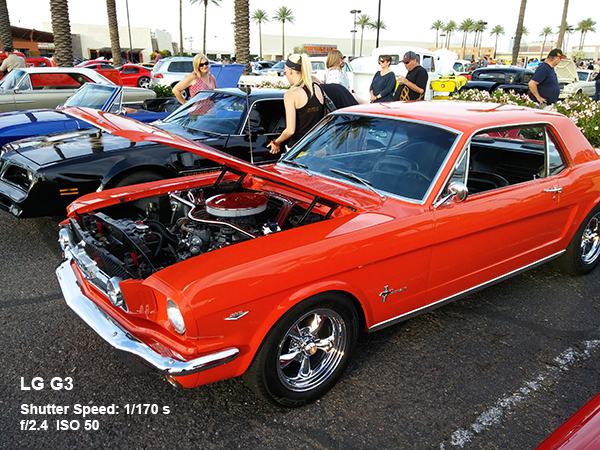

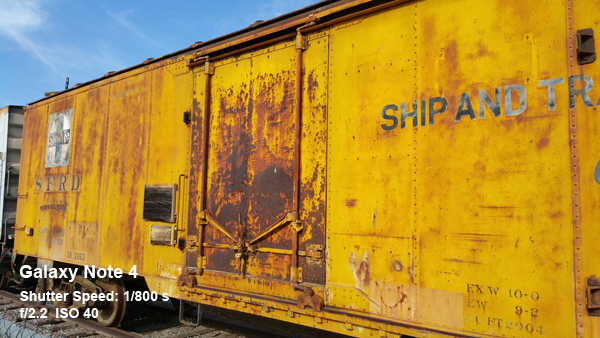




Full Size Images: [Note 4: outdoor car], [iPhone 6 Plus: outdoor car], [Nexus 6: outdoor car], [LG G3: outdoor car], [HTC Desire Eye: outdoor car], [Note 4: outdoor boxcar], [iPhone 6 Plus: outdoor boxcar], [Nexus 6: outdoor boxcar], [LG G3: outdoor boxcar], [HTC Desire Eye: outdoor boxcar]
Despite being taken in the late afternoon, the light when the car was photographed was enough that all the phones apart from the Desire Eye were able to select very low ISOs. The shutter speed selected was also high enough that there are no focus issues from camera shake. However, the iPhone 6 Plus was able to select the highest speed because the bigger pixels of its 8MP sensor were able to capture more light.
When it comes to detail in these conditions, the 16MP camera in the Note 4 trumps its competitors, but the 13MP sensors in the Nexus 6, G3, and Desire Eye are not far behind. The color accuracy and saturation of the Note 4’s image is pretty good. However, the auto white balance is perhaps a little too cool, as is the Nexus 6’s and Desire Eye's. The iPhone 6 Plus produces the most accurate color in this case. Also, while the Note 4’s dynamic range in this picture is good, the iPhone 6 Plus’s shot does look better in this department, successfully capturing the blue sky.
The image of the boxcar was shot in brighter light and allowed all the phones to select a low ISO and a very fast shutter speed. All five cameras produce a decent image in these conditions with good dynamic range. The yellow in the Note 4's image skews slightly towards green, but when zoomed in close to the rusty patina on the boxcar, the Note 4’s 16MP sensor has captured the most detail, especially when compared to the iPhone’s 8MP sensor.
Get Tom's Hardware's best news and in-depth reviews, straight to your inbox.
Overall, the Note 4 performs very well in daylight, but to be honest, so does nearly every other current smartphone. We'll need more challenging conditions to see how good its camera really is.
Night

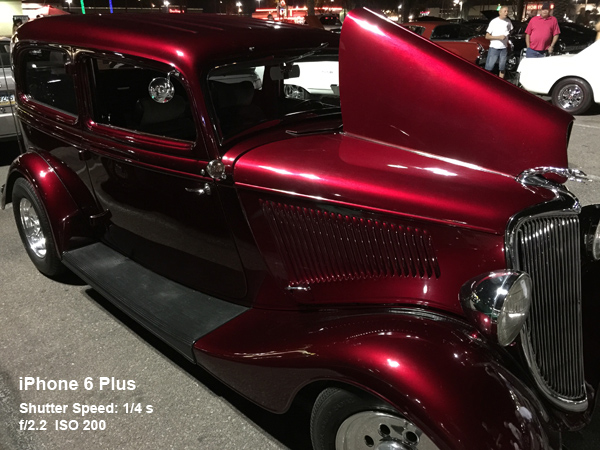







Full Size Images: [Note 4: outdoor night], [iPhone 6 Plus: outdoor night], [Nexus 6: outdoor night], [LG G3: outdoor night], [HTC Desire Eye: outdoor night], [Note 4: outdoor Gremlin], [iPhone 6 Plus: outdoor Gremlin], [Nexus 6: outdoor Gremlin], [LG G3: outdoor Gremlin]
When the light drops below a certain threshold, the Note 4 activates a night shooting mode that seems to take and combine multiple images to produce a single, brighter shot. This means shot-to-shot shooting time is slower and ghosting can be an issue for moving objects. There's also no ISO or shutter speed info recorded while in this mode. The only way to turn this mode off is to set the ISO manually. However, 800 is the highest you can set this way and it may not be enough in very low light.
The first Note 4 image in the slideshow is one shot in this mode. Zoomed out it looks ok and is brighter than that of the iPhone 6 Plus and Nexus 6, but when zoomed in you can see that the detail is soft due to the aggressive noise reduction. You can also see some haloing around some of the bright areas. Of the other images of the candy apple red 30’s Ford sedan, the iPhone 6 Plus’ is clearly the winner. Its sensor’s large pixels and OIS allowed it to take a crisp, in-focus image with a longer exposure time, while reducing noise with an ISO of 200. Still, the Note 4’s picture looks to be the runner-up, since the others either have too much noise from being taken at very high ISOs, are too dark, or in the case of the LG G3, a less effective long exposure mode.
In the second image of the white Gremlin, the Note 4 does not use its special night mode, capturing a clear image at ISO 250 and a shutter speed of 1/12 seconds thanks to its OIS. Again the iPhone 6 Plus trumps the competition, being able to produce a decent image at even lower ISO and less noise thanks to its larger pixels. However, its 8MP shot at ISO 64 is not that much more detailed than the Note 4's 16MP shot at ISO 250.
The Note 4’s low light image quality is the best of the current crop of large-screen Android phones, and certainly a step above that of its predecessors, the Galaxy S5 and Galaxy Note 3. However, the iPhone 6 Plus’ larger pixels and effective OIS mean that its low-light pictures look the best, but only by a slim margin.
HDR
All of the cameras being compared have the now obligatory HDR modes, though their implementations are slightly different. The Note 4 leverages the sensor and the SoC’s ISP to preview the HDR effect in real time, so you can see how it looks when composing the shot. The other phones, apart from the Desire Eye, apply HDR as a post-processing effect only after the photo is taken, so you will not know how the picture will look before taking it. The Desire Eye does show you a preview of the HDR effect when composing your shot, but this preview does not always reflect what the final HDR image looks like.



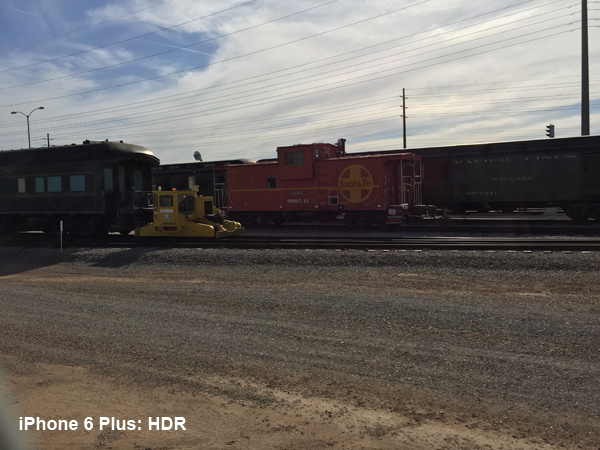





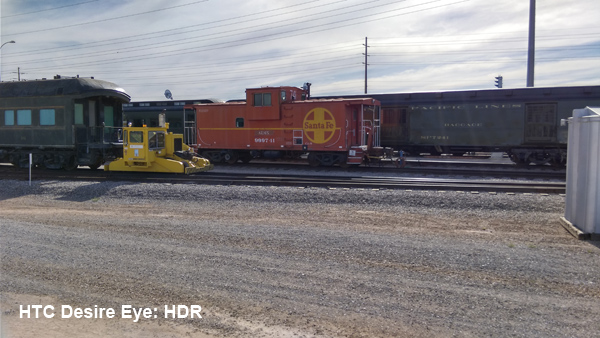
Full Size Images: [Note 4: no HDR], [Note 4: HDR], [iPhone 6 Plus: no HDR], [iPhone 6 Plus: HDR], [Nexus 6: no HDR], [Nexus 6: HDR], [LG G3: no HDR], [LG G3: HDR], [HTC Desire Eye: no HDR], [HTC Desire Eye: HDR]
In general, these comparison images show that all of the phones here have issues with dynamic range when shooting in conditions like this. In the non-HDR images the sky is overpowering the subject of the shot, so using HDR is the only way to get a good image in this light. The challenge, though, for a good HDR mode, is to brighten the areas in shadow but keep from overexposing the already bright areas.
The Note 4, G3, and Desire Eye all do a great job, though we’d have to say the Note 4 and G3 HDR images look the best. The Desire Eye goes a little too far and creates an image that looks unnatural. As for the iPhone 6 Plus and Nexus 6, their image processing is not aggressive enough and the HDR effect is minimal at best.
Additional HDR Images














Full Size Images: [Note 4: no HDR 1], [Note 4: HDR 1], [Note 4: no HDR 2], [Note 4: HDR 2], [Note 4: no HDR 3], [Note 4: HDR 3], [Note 4: no HDR 4], [Note 4: HDR 4], [Note 4: no HDR 5], [Note 4: HDR 5], [Note 4: no HDR 6], [Note 4: HDR 6], [Note 4: no HDR 7], [Note 4: HDR 7]
The Note 4's HDR mode produces some dramatic results, whether it's a street scene shot at dusk or an interior shot with a bright window in the background. Samsung definitely has the best HDR implementation right now, from the live HDR preview to the quality of the final shot. It's so good in fact, that we recommend just leaving it on all the time.
Indoors
The staged indoor shots below were lit by overhead LED lights, a CFL lamp from the front, and an incandescent overhead light in the background.
Bright Light





Full Size Images: [Note 4: indoor bright light], [iPhone 6 Plus: indoor bright light], [Nexus 6: indoor bright light], [LG G3: indoor bright light], [HTC Desire Eye: indoor bright light]
Even with all of the lights turned on, the scene is not exceptionally bright, forcing all of the Android phones to raise their ISO value. The Note 4 and Nexus 6 hold ISO a bit lower, reducing noise and producing reasonable images. Both the G3 and Desire Eye exhibit a noticeable amount of noise, even under these lighting conditions. The iPhone 6 Plus is the only camera that produces an image with lower than 100 ISO, though its detail level is noticeably less when viewed closely due to its lower resolution. As for color accuracy, the Desire Eye's and iPhone 6 Plus' white balance looks the best, while the other images are a little too cool.
There's no clear winner for this scene, but we'd say it’s a toss-up between the Note 4 and iPhone 6 Plus.
Low Light





Full Size Images: [Note 4: indoor low light], [iPhone 6 Plus: indoor low light], [Nexus 6: indoor low light], [LG G3: indoor low light], [HTC Desire Eye: indoor low light]
This scene was only lit by the incandescent light in the background, creating a very challenging scenario. The Note 4 engages its special night mode and creates an image with roughly the same brightness as the iPhone. The Note 4’s image also retains a lot of detail and is not too noisy. However, its white balance is off, giving the whole picture a green tint. The iPhone 6 Plus does well with white balance and effectively uses its OIS to hold its shutter open longer and ISO at only 250, reducing noise; however, its noise reduction algorithm leaves some odd artifacts. The rest of the phones fall down in this test. The Nexus 6’s shot is much too dark and noisy, taken at ISO 1196. The G3’s night shot is the brightest, but unnaturally so, and the color balance skews heavily towards red. Lastly, the Desire Eye’s picture is a dark, unusable mess shot at ISO 2500.
The iPhone 6 Plus has a slight edge over the Note 4 in lower-light situations, but the Note 4 is pretty close and clearly the best of the rest.
Flash





Full Size Images: [Note 4: indoor with flash], [iPhone 6 Plus: indoor with flash], [Nexus 6: indoor with flash], [LG G3: indoor with flash], [HTC Desire Eye: indoor with flash]
Both the Note 4 and iPhone 6 Plus take very nice images with the flash turned on. The Note 4 has the edge in detail, but the iPhone 6 Plus' True Tone flash produces more natural looking colors. While the flash on the Nexus 6 and G3 is capable of adequately lighting the scene, the color is too cool and the images are overexposed.
Front-Facing Camera



Full Size Images: [Note 4: Front-facing camera sample 1], [Note 4: Front-facing camera sample 2], [Note 4: Front-facing camera sample 3]
The samples from the front-facing camera were taken with the unnatural "Beauty mode" turned off. The last image is an example of the Note 4’s "Wide selfie" mode.
Additional Sample Images
The slideshow below contains a selection of images taken with the Note 4 in a variety of locations and lighting conditions, and should give you a good idea of the kind of photographs it's capable of taking.







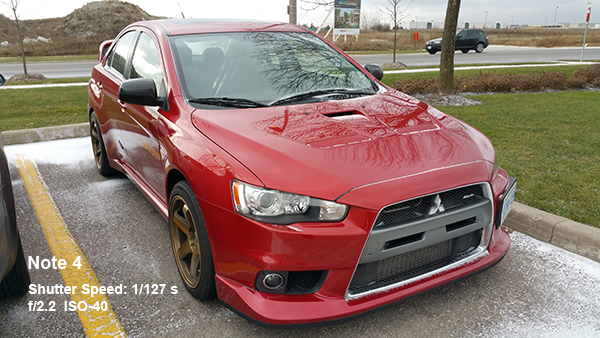










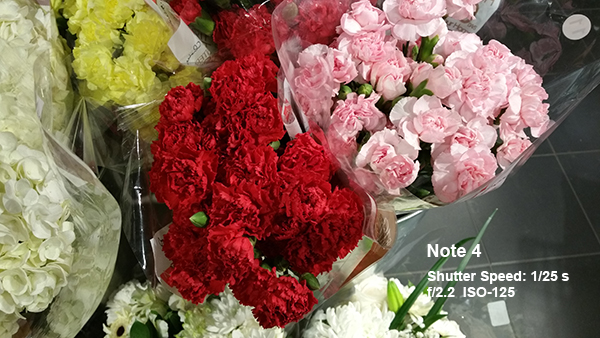



Full Size Images: [Note 4: sample 19], [Note 4: sample 20], [Note 4: sample 21], [Note 4: sample 18], [Note 4: sample 8], [Note 4: sample 13], [Note 4: sample 14], [Note 4: sample 11], [Note 4: sample 12], [Note 4: sample 9], [Note 4: sample 15], [Note 4: sample 3], [Note 4: sample 2], [Note 4: sample 10], [Note 4: sample 1], [Note 4: sample 16], [Note 4: sample 17], [Note 4: sample 5], [Note 4: sample 6], [Note 4: sample 4], [Note 4: sample 7], [Note 4: sample 22]
Overall Camera Performance
The Note 4's camera system, from its lens to the Sony IMX240 sensor to the Snapdragon 805’s ISP (image signal processor) to Samsung's software, work in harmony to make it one of the best cameras of any smartphone. It's capable of producing excellent high-resolution images that are better than all its large-screened Android peers. Only in lower light do we see the iPhone 6 Plus surpass the Note 4, and even then not by a significant amount. The Note 4 also has a number of useful camera modes, such as "Selective focus" and "Shot & more" that can produce some great-looking, unique images without having to take them into an image editor.
With PDAF, the Note 4 can focus on its subject in approximately 300ms, which is faster than the Galaxy S5's PDAF system and the G3's laser autofocus system, along with most other current smartphones. Only the iPhone 6 Plus' PDAF can focus faster. Combining this with the Note 4’s shot-to-shot performance, which is also very good and one of the quickest we’ve seen, means you won't miss capturing that fleeting moment.
Current page: Camera: Performance And Photo Quality
Prev Page Camera: Hardware And Software Next Page Software-
ZolaIII All in all nice review but I somehow feel you skipped a litle audio section. Not that I blame you much for it as Qualcomms solution is nothing special & it's far behind WolfsonMicro's WM5110 used on Exunos equipped models. Looks like you still didn't got to the bottom of bus frequency scaling dependencies on this Qualcomms SoC gen. ??Reply -
Vorador2 Replythis came out long ago!
It's a tradition. Everybody reviews phones in the week before or after a phone is released.
Tomshardware is better than that. Fashionably late to the party. -
jafrugh Replythis came out long ago!
It's a tradition. Everybody reviews phones in the week before or after a phone is released.
Tomshardware is better than that. Fashionably late to the party.
Well if you think Toms's Hardware needs to be quicker on the draw for phone reviews, go to this article: http://www.tomshardware.com/news/mobile-editors-wanted,29105.html -
Vlad Rose Replythis came out long ago!
I thought the same thing considering I'm using a Note 4 Edge right now... lol -
alex davies Replythis came out long ago!
The difference between our review and others is that we tested the Note 4 running the Lollipop update, which only came out recently.
We also compare its performance to newer devices such the Galaxy S 6, so you can see how the Note 4's older SoC compares to the latest and greatest. -
MobileEditor ReplyAll in all nice review but I somehow feel you skipped a litle audio section. Not that I blame you much for it as Qualcomms solution is nothing special & it's far behind WolfsonMicro's WM5110 used on Exunos equipped models. Looks like you still didn't got to the bottom of bus frequency scaling dependencies on this Qualcomms SoC gen. ??
I agree with you regarding our audio testing. I'm definitely not happy with it. We need to acquire some testing equipment, but the hardware we found cost $30k!!! Needless to say, we're still using my ears, because they're cheap.
If you, or any of our readers, could point me towards some audio testing equipment that mere mortals can afford, please PM me.
I did not investigate the bus scaling on the Note 4, partly because this review was finished by then and partly because the Note 4 did not exhibit "unusual" behavior. We will be examining this for the GS6.
- Matt H. -
10tacle Nice review and very useful to people like me needing an upgrade after skipping two generations of smart phones. I usually keep mine 3 years, and my Droid Bionic is like running a Core 2 Duo desktop these days. I'm still debating between the Note or Galaxy. Apples are out because 1) I don't like the fact that the battery *cannot* be removed to completely shut the phone off, and 2) no MicroSD slot for memory expansion.Reply
There will come a time when all smart phones from all manufacturers no longer allow SD memory upgrades, and I think that time is coming sooner rather than later. After all, one can go buy a 128GB $100 MicroSD card, but if Apple users want a 128GB phone, they have to shell out another $200 clams from the base 16GB model, and they don't get the extra "free" GB memory to start with after upgrading that came with the Android.
But with that said, there are some people reporting about overheating and battery drain with their Note 4. Battery drain can be a problem with the provider though like a cell tower being down. Plus, the Note 5 is coming in a few months, possibly in July. I'm hoping it still has an SD slot otherwise I'll get the 4 and hope the serious overheating and battery drain reports are a fluke.
